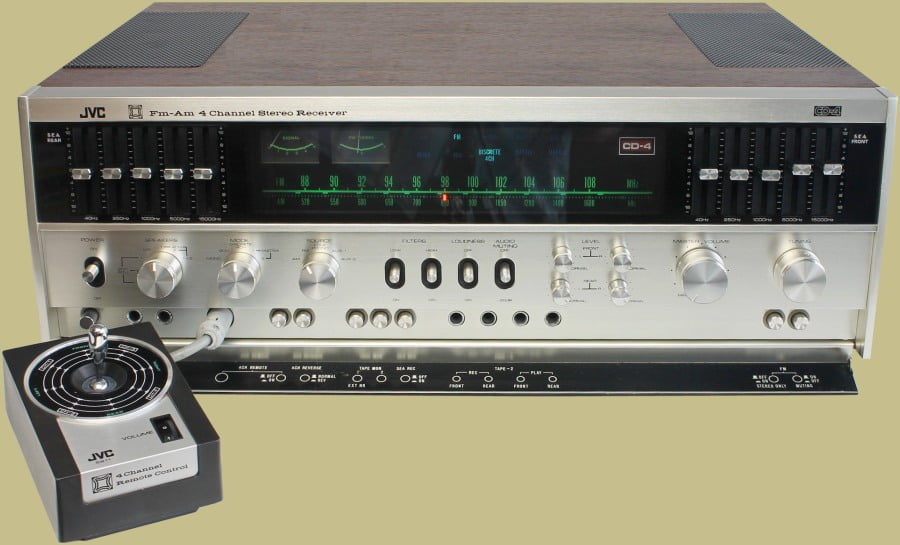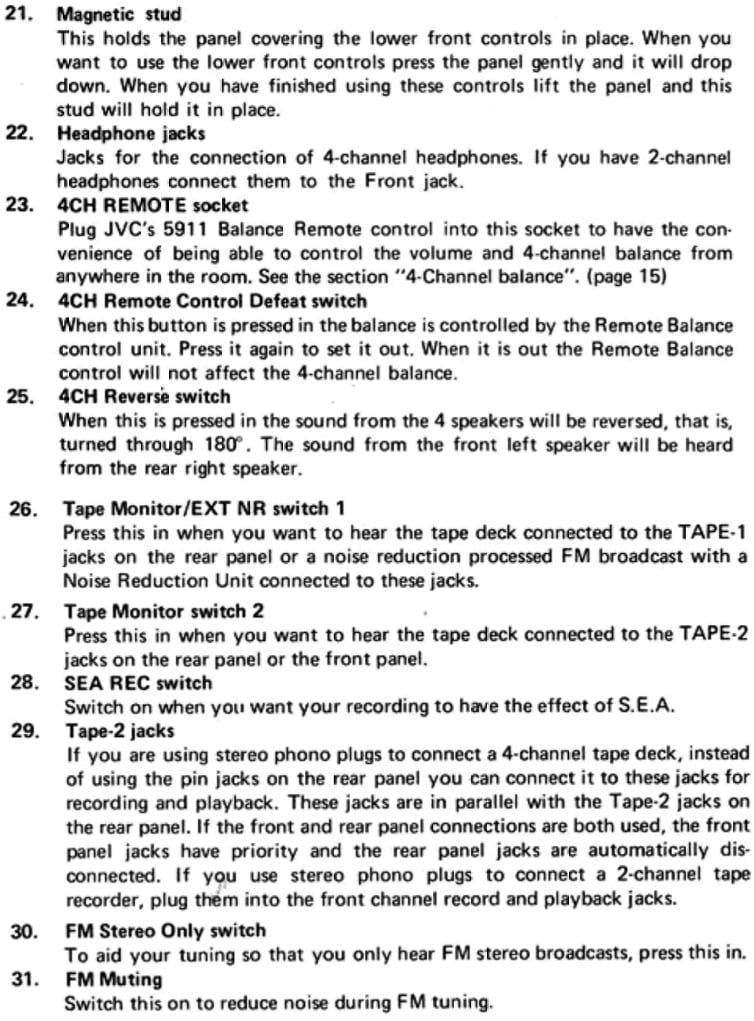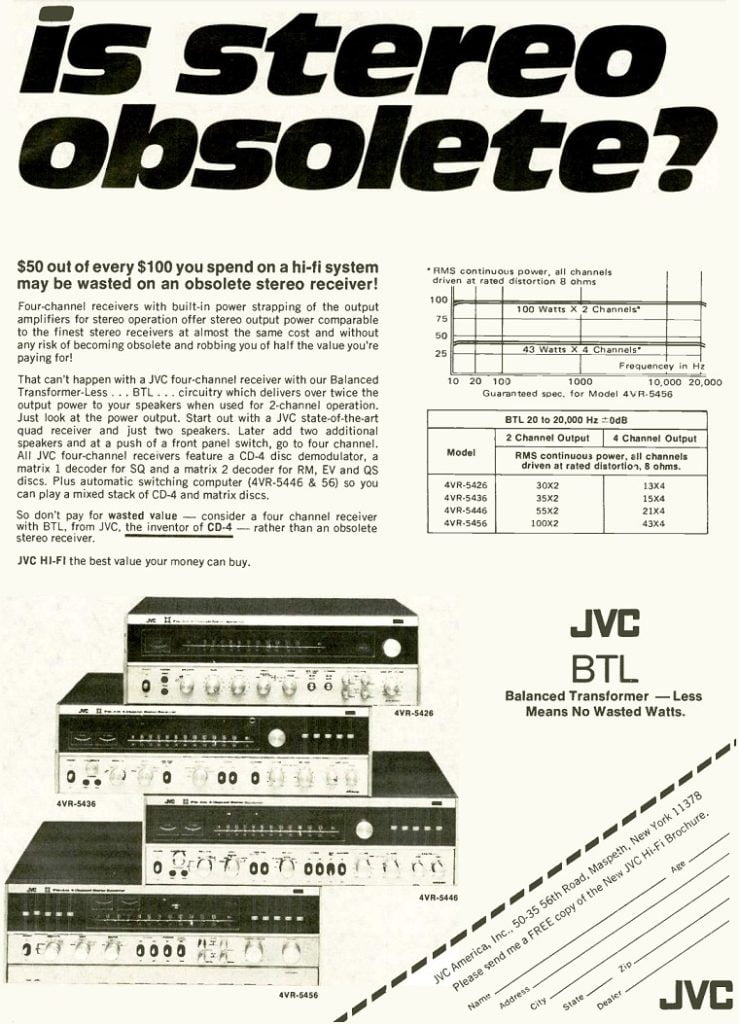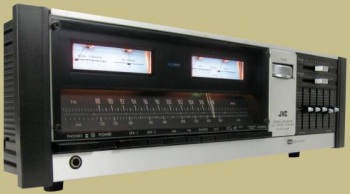
Introduced in 1974, the JVC 4VR-5456 receiver is a quadraphonic (4-channel) model that retailed for $799.95. It’s packed with features including an AM/FM tuner, CD-4 demodulator, two-position matrix decoder, and SEA multiband tone controls. It was made by the Victor Co. in Japan and distributed by JVC America. It’s not the greatest looking receiver but it has some power and is very flexible.
Apparently JVC bet heavily on the success of the 4-channel market but, unfortunately for them, that market dwindled quickly. They also bet on their own CD-4 decoding format which would have to compete with the more popular Sony SQ format and Sansui QS format. In the end the 4-channel market collapsed as consumers just didn’t seem to want them. JVC allegedly rebadged most of their 4VR line at the time and marketed them as 2-channel stereos that were “4-channel ready” as opposed to straight up 4-channel receivers. Still, they didn’t sell many overall which is why they aren’t that common today. You will see some 4VR-5456X models around. Perhaps they were part of the re-marketing effort by JVC.

The tuning dial is fairly short and centered on the top row of the front panel. This is because it is flanked on both sides by JVC’s SEA tone controls (basically an equalizer). On the left there are also two meters, a channel center FM tuning meter and an AM/FM signal strength meter. Above the meters are two rows of indicator lights. On the right side of the tuning dial are another set of SEA tone controls. The sliders on the left control the back channels while the sliders on the right control the front channels.
Below the tuning dial is the power switch followed by three rotary switches for speaker selector, mode, and source selector. You’ll notice there are two sets of 1 (main), 2 (remote), and 1+2 (both) speaker positions. One set is for regular quadraphonic use while the other connects the front and back amplifiers for 2-channel stereo use and increased power per channel. JVC calls this BTL mode (Balanced Transformer – Less). More on this later.
The mode switch has settings for mono, stereo, and discrete quad as well as matrix 1 and matrix 2. Matrix 1 is for SQ records while Matrix 2 QS or E-V matrix recordings. The third rotary switch is for switching sources.

The S.E.A., or Sound Effect Amplifier, gives you more control over tone than just control knobs would. JVC may have been the first to incorporate these EQ’s into a retail market receiver. So, while other receivers have only bass, treble, and sometimes mid controls, the JVC 4VR-5456 has 5 separate controls for both front and back. Each slider control allows you to vary the response in a different frequency range. Since in a small room the high end frequencies tend to get emphasized, and in larger rooms the lower frequencies, it’s nice to be able to compensate for this via the SEA controls.
You can vary the level, or volume, of the front and back channels via the 4 control knobs just left of the master volume knob.

The 4VR-5456 has a pop open cover along the front bottom edge that exposes more controls and inputs. Here’s what they are:


There are two muting buttons on the 4VR-5456 below the tuning knob (under the cover). One mutes everything but stereo while the other is a conventional muting circuit that mutes noise while tuning and reverts to a mono signal if needed.

It’s pretty busy inside the chassis of the JVC 4VR-5456 but that is to be expected of any 4-channel receiver. Note the massive transformer and power supply capacitors. If you’re looking at purchasing a JVC quad, or any other quad for that matter, keep in mind that they tend to be more problematic than basic 2-channel stereos. That is because of the excess circuitry that is required for the 4 channels which increases the probability of something going wrong over the years. Fortunately there are parts available for the 4VR-5456. You can find the current list of available parts on eBay HERE.
Now, back to JVC’s BTL mode mentioned above. There are four amplifier sections on the 4VR-5456, one for each channel. When you switch from quad mode to stereo mode it would be a shame to only use two of the amplifiers and let the other two sit idle doing nothing. So, JVC came up with their BTL mode which, through internal switching, reconnects to the other two amplifiers so that each channel, in 2-channel mode, goes through two power amplifiers. This means that the 4VR-5456 will go from 43 watts per channel in quad mode to 100 watts per channel in BTL stereo mode. Make sure you are using 8 ohm speakers when in BTL mode or bad things can happen. 4 ohm speakers are OK in 4-chan mode but not 2-chan.
Here is JVC’s CD-4 system including the 4VR-5456 receiver, 4DD-5 demodulator, 4VN-990 amplifier, and SX-3 speakers.

Specifications:
- Tuning range: FM, MW
- Power output: 100W/ch (stereo), 43W/ch into 8Ω (quadraphonic)
- Frequency response: 10Hz to 50kHz
- Total harmonic distortion: 0.5%
- Damping factor: 40
- Input sensitivity: 3mV (MM), 150mV (line)
- Signal to noise ratio: 70dB (MM), 75dB (line)
- Output: 150mV (line)
- Speaker load impedance: 4 ohms to 16 ohms
- Dimensions: 20 1/4″ L x 7 1/8″ H x 15 7/8″ D (180 x 405 x 513mm)
- Weight: 44 lbs (20kg)

The back panel of the JVC 4VR-5456 is crowded with connections. There is a phono input that is accompanied by a high/low sensitivity switch, inputs for AUX-1 and AUX-2, tape 1 and tape 2 inputs and outputs, a DIN input output socket, and even inputs for connecting a 4-channel oscilloscope for signal analysis.
You’ll also see three controls, adjusted by screw driver, for left separation, right separation, and carrier level. These are used for CD-4 alignment with the disc (as in vinyl LP) supplied with the receiver. JVC originally set the alignment for their 4MD-20X Shibata stylus phono cartridge but it could be aligned for others as well.
As with many receivers in the early 1970’s there are connections for a demodulator that one would use if you were receiving a discrete quadraphonic FM radio broadcast. These broadcasts never really caught on so this feature isn’t useful these days.
Of course there are also spring loaded speaker connectors for two quad sets of speakers.

JVC’s line of 4-channel receivers consisted of the 4VR-5426, 4VR-5436, 4VR-5446, and 4VR-5456. Only the 4VR-5456 had separate SEA controls for both front and back channels. The 4VR-5446 and 4VR-5436 had them for the front channels only and traditional knob controls for the back channels.
The 4VR-5456 is an interesting receiver and a part of quadraphonic audio history. I can’t really say it looks great but it’s not bad. Its power output is sufficient to drive most speakers and it has a ton of features. If you really want a quad receiver though, there are probably better options worth considering. Just remember that unrestored quads tend to have issues and may require above average expense to repair.


Hi, I ran across our old original JVC Instruction manual for the model 4VR-5456X 4 channel receiver. Is that anything you might be interested in?
Thank you.
I still have this JVC receiver but no longer have the manual, so I would be interested. My email is turbone@gmail.com
Hello do you still have this manual for the JVC 5456X? Thanks mo42279@gmail.com
I have a couple of these that I enjoy using. Lots of power, and great quadraphonic sound. I feel that JVC put a lot of effort into this one.
I still have mine. Looks and acts like new. Is anyone interested in it? (JVC turntable and dual tape deck too.)